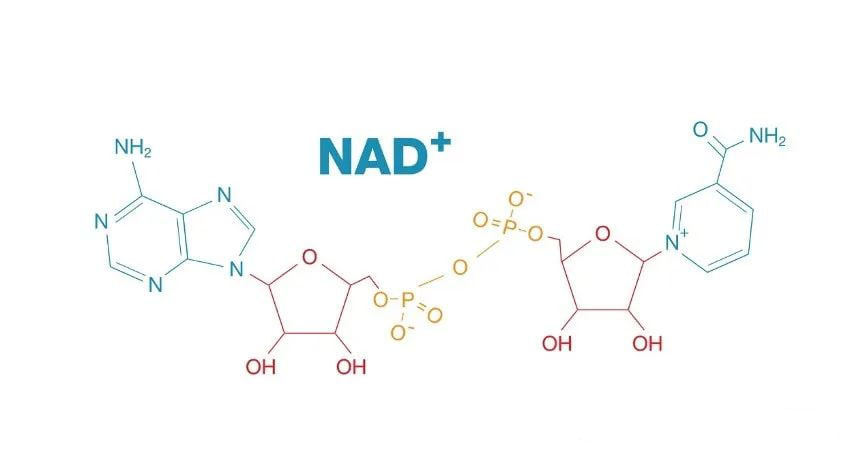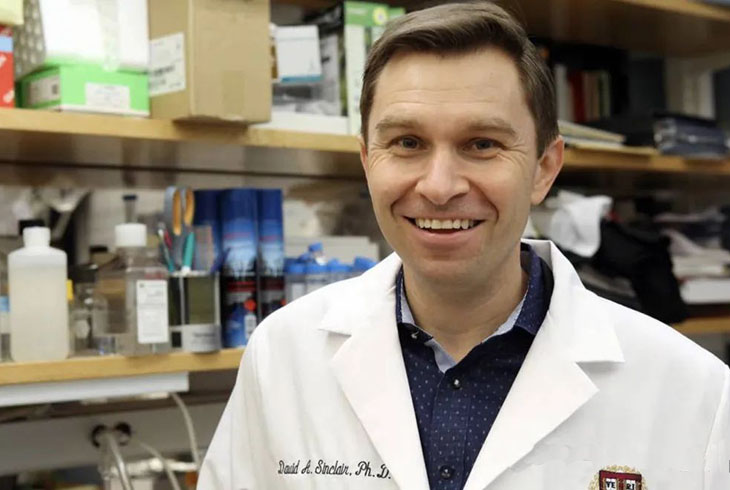NAD+ (nicotinamide adenine dinucleotide) is an important coenzyme widely present in organisms. It participates in regulating a variety of biochemical reactions and plays a key role in many aspects, from cell energy metabolism to DNA repair. NAD+ is an important coenzyme in the tricarboxylic acid cycle, promoting the metabolism of sugars, fats, and amino acids, and participating in the synthesis of human energy. In addition, NAD+ is the only substrate for coenzyme I consuming enzymes (the only substrate for DNA repair enzyme PARP, the only substrate for longevity protein Sirtuins, and the only substrate for cyclic ADP ribose synthetase CD38/157), and plays a vital role in various physiological processes in organisms.
One of the main functions of NAD+ is to activate the body's longevity factor, slowing down the aging process and prolonging life by maintaining the length of telomeres. It also helps promote DNA repair, slow down the rate of cell aging, promote cell regeneration, and increase cell energy production, thereby resisting immune system diseases and maintaining the health of the body. However, as we age, the NAD+ content in the human body will drop significantly, leading to the appearance of various aging symptoms. Therefore, maintaining sufficient NAD+ content in cells is essential for maintaining normal body function.

- Molecular formula of NAD+
NAD+ (Nicotinamide Adenine Dinucleotide), full name nicotinamide adenine dinucleotide, has become a key breakthrough in the field of human aging inhibition. In 1904, the outstanding British biochemist Sir Arthur Harden (1865-1940) first discovered and named NAD+, and was awarded the 1929 Nobel Prize in Chemistry. This discovery was like a bombshell, shaking the entire field of aging inhibition and triggering widespread scientific attention and research. Many Nobel Prize winners, including Hans von Euler-Chelpin (1873-1964) and Otto Heinrich Warburg (1883-1970), have conducted in-depth research on NAD+, and its history has spanned a century.
Today, humans have a deep understanding of the outstanding functions of NAD+ and its mechanism of action in aging inhibition. This valuable knowledge not only enriches our scientific knowledge, but also provides a solid theoretical foundation for clinical practice and the research and development of aging inhibitors.
- Function of NAD+
As a key molecule widely present in nature, NAD+ is an indispensable part of the regulation of cellular energy metabolism, from single-cell bacteria to complex multicellular primates. In the core of the cell, mitochondria, NAD+ plays a vital role. Mitochondria produce electrons through a series of metabolic reactions, which, after binding to NAD+, convert it into reduced NADH, which drives energy production. Once NAD+ levels are insufficient, cells will not be able to effectively generate energy to maintain their survival and function.
NAD+ not only helps to efficiently convert food into energy, but also plays a core role in maintaining the integrity of DNA and ensuring the normal functioning of cells, thereby protecting our bodies from aging and disease. In short, without NAD+, many organisms will inevitably face a rapid decline in life activities.
- NAD+ decline is an important trigger for age-related diseases
As we age, NAD+ levels decrease (see Figure 1)2. “By the age of 50, NAD+ levels in the body are about half of what they were at the age of 20,” the study authors said in an interview.
As NAD+ levels decrease, DNA repair, cellular stress response, and energy metabolism regulation mechanisms are severely affected, which may lead to a series of age-related diseases. The specific mechanisms of these effects may be closely related to metabolic disorders such as overactivation of PARP (adenosine diphosphate ribose polymerase), decreased immune system function, and downregulation of SIRT (NAD+-dependent deacetylase, also known as "longevity protein") expression.
These metabolic disorders may in turn induce the occurrence of a variety of diseases, including but not limited to obesity, insulin resistance, diabetes, hypertension, non-alcoholic fatty liver disease, atherosclerosis, Alzheimer's disease (commonly known as senile dementia), retinopathy, and depression. These findings emphasize the importance of maintaining NAD+ levels in preventing and treating age-related diseases.
- NAD+ biosynthetic pathway and biosynthetic precursors
There are currently three known NAD+ biosynthesis pathways: the de novo pathway, the Preiss-Handler pathway, and the salvage pathway. In mammals, the salvage pathway is particularly critical and is considered to be the main synthesis pathway for maintaining normal levels of NAD+ in cells (as shown in Figure 2).
In the kynurenic acid pathway, NAD+ is derived from tryptophan, an essential amino acid found in foods such as meat, cheese, eggs, and fish. Tryptophan is converted to quinolinic acid (QA) through enzymatic and non-enzymatic reactions, and then QA is converted to nicotinic acid mononucleotide (NAMN) under the catalysis of quinolinic acid phosphoribosyltransferase (QAPRT). In addition, NAMN can also be produced through the Preiss-Handler pathway, when niacin (NA) in food or dietary supplements is catalyzed by nicotinic acid phosphoribosyltransferase (NAPRT).
In these two NAD+ synthesis pathways, NAMN is further converted into nicotinic acid adenine dinucleotide (NAAD) under the catalysis of NMNAT, and then NAAD is finally converted into NAD+ under the action of NAD synthetase (NADS).
The salvage pathway for NAD+ biosynthesis is closely linked to the intake of natural compounds related to vitamin B3, including nicotinamide, nicotinic acid, nicotinamide mononucleotide (NMN), and nicotinamide riboside (NR). Among them, NAM, as the starting molecule, comes from both food intake and metabolites of NAD+ consuming enzymes (such as byproducts of NAD+-dependent sirtuins, PARP, CD38, etc.). First, NAM is converted into NMN under the catalysis of nicotinamide phosphoribosyl transferase (NAMPT), and then NMN generates NAD+ under the catalysis of NMNAT.
It is worth noting that NAMPT plays the role of a rate-limiting enzyme in mammalian NAD+ synthesis, and its expression level changes highly dynamically with cellular stress (such as DNA damage, starvation, etc.). In addition, obesity and high-calorie diets can lead to reduced levels of NAMPT and NAD+ in multiple tissues.
There are five NAD+ precursors, namely NA (niacin), NAM (nicotinamide), NMN (nicotinamide mononucleotide), NR (nicotinamide riboside) and NAR (other related precursor compounds, as shown in Figure 3).
By supplementing these NAD+ precursors, the biosynthesis of NAD+ can be effectively promoted, thereby increasing the level of NAD+ in the body. Therefore, NAD+ precursor supplements are regarded as a potential therapeutic strategy for delaying aging and improving age-related diseases, and have broad prospects for medical application.

Chemical structures of 5 NAD+ precursors
For example, in-depth studies have shown that supplementing with NMN (nicotinamide mononucleotide) may prevent and treat a variety of tissue damage and diseases by significantly increasing the level of NAD+ in the body. Specifically, NMN supplementation helps reduce obesity and protect vascular health, reduces neuroinflammation to improve Alzheimer's disease and cognitive impairment, and also improves immune system function and muscle health.
At present, most relevant conclusions are based on animal studies, but research in this field is gradually expanding to human trials to further verify the potential therapeutic effects of NMN.
- Benefits of increasing NAD+ levels to your health
Given that reduced NAD+ levels are closely linked to accelerated aging, metabolic disorders, heart disease, and neurodegenerative diseases, increasing NAD+ levels has significant potential benefits.
These benefits include, but are not limited to, slowing down the aging process, reversing age-related diseases (such as metabolic diseases, Alzheimer's disease, heart disease, and decreased muscle function), and thereby extending healthy lifespan (as shown in Figure 4).
Therefore, the improvement of NAD+ levels has become a focus of attention in scientific research and medical fields.
- Ways to Increase NAD+ Levels in the Body
NAD+ levels can be increased by enhancing its biosynthesis in the body, which can be achieved mainly through two ways: one is to enhance the activity of enzymes involved in NAD+ biosynthesis, and the other is to directly supplement NAD+ precursors.
① Cultivating a healthy lifestyle, such as fasting and exercise, is not only beneficial to mental health, but also can effectively increase the level of NAD+ in the body. Microbial studies have revealed that calorie restriction can activate the NAD+-dependent gene sirtuins in yeast, thereby promoting an increase in NAD+ levels. Similarly, in human studies, aerobic exercise and resistance exercise have also been shown to restore age-dependent enzyme activity in muscles involved in NAD+ synthesis.
② Another way to increase NAD+ levels is by supplementing NAD+ precursors, such as NMN (nicotinamide mononucleotide) and NR (nicotinamide riboside). These two substances are biosynthetic precursors of NAD+, and they increase the level of NAD+ in the body through the "salvage pathway" of NAD+ biosynthesis.
At present, the safety of human consumption of NMN and NR has been preliminarily verified, and no significant safety issues have been found.
- The Future of NAD+
As the world's population ages, people enjoy more time together as families; however, this also brings a heavy burden of chronic diseases in the elderly.
According to data from the National Bureau of Statistics at the end of 2019, the population of my country aged 65 and above has reached nearly 180 million, accounting for 12.6% of the total population. According to the United Nations standards, my country has long entered an aging society. Even more serious is that a study by the Chinese Center for Disease Control and Prevention shows that among the elderly aged 60 and above, as many as 75.8% suffer from one or more chronic diseases, and many people suffer from multiple diseases at the same time.
This has caused many young children in dual-parent families to bear the heavy financial burden of supporting four elderly people and paying for a variety of chronic disease treatment drugs.
As the aging trend becomes increasingly obvious, it has become a top priority to solve the problem of age-related chronic diseases to reduce health and economic burdens. At present, scientists may have found a potential solution - NAD+.
This "miracle molecule", hailed as one that can restore and maintain cell health, has shown therapeutic potential for a variety of diseases, including heart disease, diabetes, Alzheimer's disease and obesity, in animal experiments.
Scientists are still conducting in-depth research on NAD+. In the future, if the safety and effectiveness of NAD+ supplementation is confirmed in humans, it will become a key step in solving the burden of elderly diseases and turning ideals into reality.
References
- https://www.nmn.com/precursors/what-is-nad.
- Massudi H , Grant R , Braidy N , et al. Age-Associated Changes In Oxidative Stress and NAD+ Metabolism In Human Tissue[J]. PLoS ONE, 2012, 7(7).
- Johnson S , Imai, Shin–ichiro. NAD+ biosynthesis, aging, and disease[J]. F1000 Research, 2018, 7.
- Okabe K , Yaku K , Tobe K , et al. Implications of altered NAD metabolism in metabolic disorders[J]. Journal of Biomedical Science, 2019, 26(1).
- Hong W , Mo F , Zhang Z , et al. Nicotinamide Mononucleotide: A Promising Molecule for Therapy of Diverse Diseases by Targeting NAD+ Metabolism[J]. Frontiers in Cell and Developmental Biology, 2020, 8:246.
- Aerobic and resistance exercise training reverses age‐dependent decline in NAD+ salvage capacity in human skeletal muscle[J]. Physiological Reports, 2019, 7(12).
- Wang Limin, Chen Zhihua, Zhang Mei, et al. Study on the prevalence and disease burden of chronic diseases in the elderly population in China[J]. Chinese Journal of Epidemiology, 2019, 40(3):7.
- Source:https://www.nmn.cn/nad





